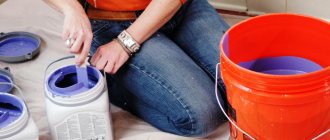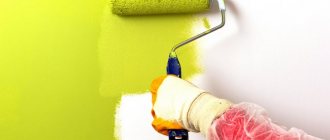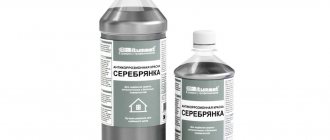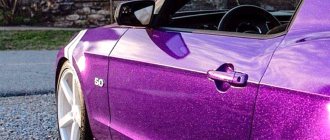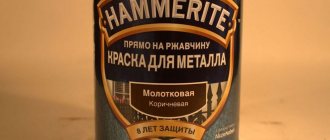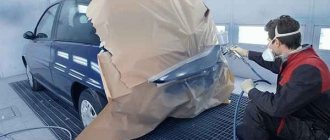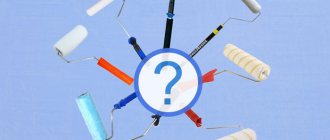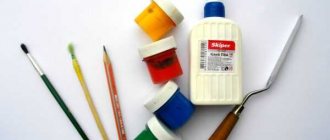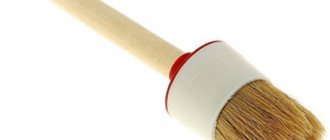Cocktails are different and not all of them are intended to be taken “on the chest”. The paints and varnishes that we use to restore a car's paintwork are also cocktails - properly prepared mixtures of several ingredients. And since we strive to ensure that the restored car (fender, door) after repair sparkles brighter than a new one, and the paint lies evenly, then our “paint cocktail” must be prepared competently, carefully and carefully, and not concocted anyhow.
Why thin the paint?
When the preparatory work on the body is completed, microcracks still remain on the surface, invisible to the eye. It is necessary to dilute the paint so that it can fill all cracks and microcavities. The dilution process allows you to reduce the viscosity of the composition and density. Due to dilution, the dye better adheres to the surface in a thin and uniform layer.
Also, the specifics of the work depend on the physical properties of a particular coloring composition. If a spray gun will be used as the main working tool, then the paint for painting the car must be diluted to a liquid state. This will allow the coloring material to pass through the spray nozzle better. When working with a brush, the viscosity of the paint should be lower.
Also, the composition must dry quickly so that smudges and other defects do not appear on the body. To minimize the cost of purchasing the necessary materials and at the same time not lose the quality of the painting, you need to know how to properly dilute the paint, depending on its composition.
Selection of substance
Given the variety of uses of acrylic, the choice of dilution method and the type of liquid often differ. To paint furniture or create decor, liquid paint is required. This approach does not eliminate unevenness and defects. In this area, water is more often used, and solvent for alkyd paint should be avoided.
But we will pay attention to what solvent to dilute car paint with. There are 2 leading types of solvent that are usually preferred by professionals:
If, for comparison, we consider how to dilute alkyd paint, then only a special solvent is used. Many manufacturers make the composition suitable for dilution with universal solvents, while others create special liquids and sell them separately.
Composition of car paints
All automotive paints and enamels contain three basic components:
- pigment is a powder substance that gives paint the required color;
- binder base - it holds the pigment and ensures adhesion of the material to the surface;
- solvent - with its help the composition is given the necessary consistency.
Different types of dyes have different physical characteristics - elasticity, density, degree of fullness, and hardness of the layer after drying.
Filtering
The prepared paint and varnish material must be filtered before filling into the tank of the spray gun, as it may contain foreign inclusions that got there during the preparation process, clots, etc. Otherwise, it is impossible to guarantee a high-quality coating, because all this debris may ultimately end up on the surface being painted.
For filtration, it is convenient to use disposable paper funnels with a nylon filter insert (mesh size, usually 190 microns). I inserted the funnel directly into the tank, strained it - ready, you can paint!
We fill the paint tank only using a filter funnel.
Types of solvents
Any automotive enamel is sold in liquid form, but this does not mean that it can be used immediately. The manufacturer has already added a solvent to the paint, but just enough so that the composition does not dry out. To obtain an even coating, the material should be diluted additionally. This coating will protect the body from damage and corrosion.
Before mixing paint with solvent, you need to remember that the manufacturer has already added a certain amount. Depending on this, coloring compositions are divided into:
- highly filled;
- medium filled;
- low-filled.
Fullness is a property that determines the volatility and viscosity of the enamel; it helps to understand how much more solvent can be added.
By evaporation rate
Solvents, just like paints, come in different forms; let’s look at their main types. Depending on the evaporation rate, the following compositions are distinguished:
- Slow - they are used for work in the summer or at high temperatures.
- Fast - the components in the composition speed up the drying process and make it possible to work with the material even in winter.
- Universal - allowed for use at average temperature conditions.
According to physical and chemical indicators
Depending on the physical and chemical characteristics, two groups of solvents are distinguished:
- Polar - alcohol, ketones, substances with hydroxyl group molecules. These materials are suitable for working with acrylic paints.
- Non-polar - white spirit, kerosene, a complex of hydrocarbon-based compounds.
In order to accurately determine how to dilute a particular paint, you should find out what solvent the manufacturer used. Match polar to polar or non-polar to non-polar.
Peculiarities
An important feature of acrylic is its naturalness; the environment does not suffer from the use of an automotive composition. There are no fumes or strong odor from the paint. The advantage of acrylic is the variety of shades; it is easy to obtain any color using special pigments in the appropriate dosage.
Due to its water base, the substance is resistant to fire. The listed qualities contribute to the use of acrylic in residential premises and small spaces. Water evaporates quickly, causing the material to harden faster than its analogues. An important advantage of the composition is that acrylic can be diluted even after drying, so the substance will return to its original form. You just need to know how to dilute acrylic paint and the recommended dilution rates.
Acrylic auto enamel Mobihel
How to dilute paint correctly
The manufacturer indicates on the packaging how much solvent needs to be added to achieve the desired consistency. For example, in the case of using acrylic, which already contains a certain proportion of activator, solvents are added in a minimal volume - the proportion is 10-15% of the total amount of paint.
How to dilute paint if it is a two-component composition? Many people use the following proportions: for 1 liter of paint they use 0.5 liters of solvent and 150 ml of hardener. How correctly the proportion is observed, the quality of the result will be.
To ensure that the paint is prepared correctly, experts recommend using a measuring ruler or flask. This is necessary to ensure that the proportions of the coloring composition, hardener and solvent fully correspond to those recommended by the manufacturer.
You should also obtain the correct viscosity of the diluted mixture - this is determined using a viscometer. You can determine the viscosity by eye - the liquid should drip and not flow in a stream.
Viscosity also varies depending on how and with what the coloring is done. So, for spray guns with a small nozzle, it is necessary that the coloring composition be liquid, but for working with a brush or roller, you can make the dye thicker.
Experts recommend that mixing containers have a strictly cylindrical shape. This is the only way to mix all the ingredients evenly and measure the quantities correctly. The best measuring container is a plastic jar with a lid. There are markings on it that allow you to mix components in different proportions. The base is poured into the container to the required division, and then a hardener or solvent is added there. Using a measuring ruler, the components are conveniently mixed - the paint is diluted.
Often a measuring ruler is sold along with the paint, and on cans of famous brands there are always proportions according to these rulers.
In the video: how to simply dilute paint.
50% hardeners and up to 20% solvent are added to the two-component composition. The degree of dilution of the base enamel can range from 50% to 80%. It’s best to look at the instructions for exactly how to dilute the paint.
Ingredients
First of all, let’s decide on the type of our “paint cocktail”: will it be regular acrylic enamel (which is less likely), or metallic or pearlescent paint (most likely).
Regular acrylic enamel is two-component, with a hardener. The “ingredient kit” for such materials consists of three jars. For example, a liter of paint, half a liter of hardener and 100-150 ml of thinner. That is, when buying a liter of paint, you actually get about 1.6-1.7 liters of diluted paint.
This must be taken into account when selecting paint: some laboratories indicate prices for “thick” paint, and some for “thinned” paint. The difference, as you yourself understand, is huge.
In the case of “metallic”, the base paint is necessarily covered with a transparent varnish on top - without it, spectacular coatings look inconspicuous, and the weather resistance of two-layer coatings is much higher. Transparent varnish, like acrylic enamel, is two-component, with a hardener. But the “base” does not need a hardener - it is one-component.
Thus, the “set” for two-layer coatings already consists of five cans. For example, a liter of “base”, 500-700 ml of thinner for it, a liter of transparent topcoat varnish, half a liter of hardener and 100-150 ml of varnish thinner - a total of 3.3 liters! At the same time, the diluted paint itself was no longer there, the same 1.7 liters.
Dilution of metallic paint
Metallic paints differ from traditional ones by the presence of aluminum powder in their composition. These are auto enamels that consist of a binder, pigment, solvent, and small metal particles. The paint should be applied in a thin and even layer - for this it must be liquid. Let's see how to thin metallic paint.
The most commonly used proportion of solvents and coloring compounds is 1:1. But this depends on the method of application of the latter. First of all, the surface is painted with a dry layer - for this you should prepare 2 parts of dye and 1 part of solvent. Then a second thick layer is applied, basically in a ratio of 1 to 1. After drying, another similar layer is applied, but thinner.
To paint a car well, you need to choose the right dye and color. There are many colors to suit every taste, and we already know how to dilute them correctly. Therefore, high-quality results are guaranteed.
Additional recommendations (2 videos)
Various solvents (23 photos)
Communities › All about Paint and Painting › Blog › Is it possible to restore dried paint?
There are a couple of plastics of selected metallic paint. 2 kg. In a year it has dried, but not into stone, it is still viscous. I tried it with solvent 650 and it soaks it up beautifully. But what is the best way to paint parts or what is the best way to dilute them?! And what proportion
Comments 65
Since last year there was a base, I took it for bottling, when I opened the jar, it was like thick honey, I just added thinner to the desired viscosity and painted it, it was fine. I’m not saying that this can be done, but what’s stopping you from diluting and painting, we would have found the answer faster than reading all the comments)
thinner and dilute)
You're right, throw away the paint and forget about it, because if you use it you'll end up with hemorrhage later.
Well, I’m definitely not going to throw anything out, I’d rather paint something for her
2 Development options (professional advice without emotions)
1. The most budget-friendly. You go to the auto enamels store and buy a solvent for the base, now since it’s hot and slow 2 liters, most base coats usually have a 2:1 ratio, that is, for 2 liters of metallic paint there is 1 liter of thinner, but there are some base coats that TDS are diluted in a 1:1 ratio, then you need 2 liters of diluent for 2 lire of base, how to understand how much diluent is needed, take a container and mix in a 2:1 ratio, if the enamel in the container has the consistency of kefir, then the proportion is 1:1 and you need to add another thinner, how to understand that the enamel has already been diluted - very simply take a 190 micron nylon funnel (a strainer is sold in car enamels) and fill it, the diluted paint will pass through the funnel in about 18-20 seconds, that is, the ready-to-apply base is slightly thicker than the solvent )
2. Go to the auto enamels store and buy 200 grams of binder - a colorless resin binder, come, take a bucket, pour the binder, your paint, and the solvent into it according to point 1.
When mixed enamel is stored according to the formula for a long time in a plastic container, the solvent is the first to evaporate, then the binder contained in pigments (toners, grains) since these ingredients have the lowest density and these compounds are more volatile, therefore by adding resin and thinner you will return the enamel to its original state .
PS There have been cases when so-called dissolved crackers were used, when the solvent was completely evaporated from the base; without adding a binder, streaks and cloudiness are possible on complex metallics; if you add a binder, everything will be fine.
Sofa experts, exhale and visit the community with naked women)
Listen, you are an uncouth worm to your grandmother. want a discussion? Let's discuss. So how did you determine that the garage expert database died? Or are you an expert on sour cabbage soup? Or on blogs? I don’t write blogs, I work on paint and paint and give advice according to the customs regulations, and you are throwing out products intended for disposal by a plumbing device called a toilet.
I see your verbal diarrhea does not stop and there are no specifics on the case. And now the numbers: a binder of 200 grams costs 800 rubles, a grower for a base of 2 liters costs 800 rubles, a total of 1,600 rubles, and 2 kilos of metallic from 7,000 thousand. Did you steal it? There is no need to count other people's money and give advice to throw away something. The person himself will figure out what to throw away and what not. As for stickiness, your thinking is sticky, if you were hooked by competent advice, then that’s your problem.
The easiest way is to post a link to ready-made Chinese paints. Why do they also pick up 1000?
2 Development options (professional advice without emotions)
1. The most budget-friendly. You go to the auto enamels store and buy a solvent for the base, now since it’s hot and slow 2 liters, most base coats usually have a 2:1 ratio, that is, for 2 liters of metallic paint there is 1 liter of thinner, but there are some base coats that TDS are diluted in a 1:1 ratio, then you need 2 liters of diluent for 2 lire of base, how to understand how much diluent is needed, take a container and mix in a 2:1 ratio, if the enamel in the container has the consistency of kefir, then the proportion is 1:1 and you need to add another thinner, how to understand that the enamel has already been diluted - very simply take a 190 micron nylon funnel (a strainer is sold in car enamels) and fill it, the diluted paint will pass through the funnel in about 18-20 seconds, that is, the ready-to-apply base is slightly thicker than the solvent )
2. Go to the auto enamels store and buy 200 grams of binder - a colorless resin binder, come, take a bucket, pour the binder, your paint, and the solvent into it according to point 1.
When mixed enamel is stored according to the formula for a long time in a plastic container, the solvent is the first to evaporate, then the binder contained in pigments (toners, grains) since these ingredients have the lowest density and these compounds are more volatile, therefore by adding resin and thinner you will return the enamel to its original state .
PS There have been cases when so-called dissolved crackers were used, when the solvent was completely evaporated from the base; without adding a binder, streaks and cloudiness are possible on complex metallics; if you add a binder, everything will be fine.
Sofa experts, exhale and visit the community with naked women)
Source
What can we say in the end?
In the automotive market, acrylic paint is still one of the undoubted leaders among painters. This is justified by the low price in comparison with the same metallic, xerallic or mother-of-pearl. Good performance characteristics, high drying speed and the classic appearance of the acrylic helmet-painted surface of the part, which is very similar to the factory layer, make it more popular among competitors. It is chosen by comparing it with nitro enamel, which also has its advantages and many people use this coating in their work.
Sources
- https://topreit.ru/materialy/pokraska-mashiny-akrilom/
- https://kraski-net.ru/pokraska-avtomobilya/avtokraska/opisanie-i-harakteristiki-akrilovoj-kraski-vika
- https://www.driver-helper.ru/text/sovetiy/luchshaya-kraska-dlya-avtomobilya
- https://avtomaliar.ua/skolko-sohnet-avtoemal
- https://kuzovspec.ru/pokraska/sushka-avto/
- https://krasimauto.com/pokrasochnie-raboty/skolko-sohnet-kraska-na-avto-posle-pokraski.html
- https://MyKrasim.ru/kraska/pokraska-auto/vysyhaniya-avtomobilnoj-kraski
- https://PokraskaMashin.ru/tehnologiya-okraski/okrashivanie-avto-akrilovoy-kraskoy/
- https://krasimauto.com/pokrasochnie-raboty/pokraska-avto-akrilovoy-kraskoy.html
Content
However, even if a thinner is not included, the packaging must indicate which one is suitable for this particular paint and its recommended amount. Don’t neglect these instructions: there are many manufacturers, car enamels have different compositions, and if you don’t want to ruin the body of your car or spend money on repainting it, you should read what the manufacturers wrote on the can.
How to dilute car paint and how much to pour such liquid also very much depends on the ambient temperature. So before buying a solvent, it is worth assessing all the conditions in which you are going to paint.
Measuring viscosity
Any painter should be able to control such a vital indicator as viscosity. For what? So that it corresponds to the recommended value. Again, why? To evenly apply the material to the surface and obtain a coating of the required thickness with the planned properties - beautiful and durable.
“Viscosity” (from Latin viscosus - sticky, sticky) is a value characterizing the fluidity of a liquid.
For what?
For more details, use the example of filler soil. The surface that we cover with it has various kinds of micro-irregularities left after preparation (grinding marks, pores, etc.). In other words, protrusions and recesses. From the deepest to the highest point - approximately 50 microns.
So, if we apply too liquid a filler to this surface, its thin film will not be able to cover these irregularities, and even with a margin for grinding (by analogy: if you put pebbles on the bottom of a jar and pour water without covering the stones with head"). As a result, the surface will remain uneven and the material will, by and large, be wasted. You have to do extra work - reapply the filler, spending twice as much time on repairs.
Let's take the opposite situation with applying too thick filler. It would seem that there certainly shouldn’t be any problems here. No matter how it is. A filler that is too thick and non-flowing, again, will not be able to properly fill all the micro-irregularities - its penetrating ability is too low and it is simply not able to flow into these small depressions (just as a soccer ball cannot fall into a golf hole).
The coating turns out to be loose, poorly adhered to the surface, and subsequently the filler begins to peel off. Not a very rosy prospect, but the troubles don’t end there. A filler that is too thick will not be able to spread over the surface in a smooth layer; increased shagreen is formed, which leads to torment and excessive consumption of materials during sanding.
And this is just a filler primer! What can we say about paints and varnishes? Gloss, shade, texture and adhesion again... All this directly depends on viscosity.
Someone will ask: “What if you dilute it thinner so that it flows everywhere, adheres well and spreads smoothly, and apply it thicker so that there is a reserve for leveling by sanding? The thicker, the better the protection!”
We don't recommend it. A thick layer of liquid material contains a large amount of solvent - the coating will harden for a very long time (not hours or days - months until it dries completely), and enamel applied on top of an undried primer can lead to wrinkling of the coating and poor adhesion between the paint and the primer. In addition, the likelihood of such unpleasant defects as “boiling” and many others increases.
So, it is necessary to be able to control viscosity. The question arises: how?
In everyday life, measuring viscosity most often looks like this: a painter takes a long object (say, a screwdriver), dips it into a jar of prepared paint and, based on one sign known to him, determines whether the viscosity is optimal or needs to be diluted more. Roughly speaking, if you like the way the mixture flows from a screwdriver, great, let's go paint it. If you don’t like it, make it thinner by adding a solvent, or thicker by adding the main product and hardener (if added).
We must say that if this method is good, it is only for professionals with very extensive practical experience. They, as they say, feel the paint and varnish material with their skin. What should novice painters, those who don’t have much experience, do?
We remember from school physics that viscosity is usually measured in pascal seconds (dynamic viscosity) or in square meters per second (kinematic viscosity). It is also known that methods for determining the true viscosity properties of liquids are quite complex, and therefore unsuitable for use in repair shops. Therefore, such a concept as “conditional viscosity” was introduced into circulation.
Determining conditional viscosity comes down to measuring the time (in seconds) when a certain volume of liquid (100 ml) flows from a funnel through a hole of a certain diameter (usually 4 mm).
So don’t be surprised when you see the inscription on a can of enamel: “working viscosity 22-24 s.” This just means that the material should be diluted to a conditional viscosity of 22-24 s, which is determined using a special device - a viscometer, which is a cylindrical measuring container with a volume of 100 cm³ with a conical lower part and a hole in it.
Tips for choosing
The composition of car paint always includes additional components, fillers, solvents, fixatives and additives, the addition of which significantly changes the chemical composition and physical properties of the paintwork. You should definitely show maximum attention to them.
In addition, be sure to study the technical specifications declared by the manufacturer:
- viscosity;
- drying speed;
- best before date;
- compatibility with varnish and chemicals;
- overlap;
- temperature and characteristics of the drying process;
- color palette and color accuracy.
It is important to understand that some manufacturers produce paint in colors that are designed for a certain model range of cars and do not always suit your car. Usually this information is also indicated on the packaging.
The cost of the can, the mixing mechanism, the difficulty of applying paint to car body parts, the environmental friendliness of the composition and the requirements for painting conditions are also important. If the paint is toxic or requires a difficult microclimate in the paint booth area, it may make sense to choose a different paint coating.
In conclusion, it should be noted that choosing paint enamel for painting a car is difficult only if you are not familiar with the basic characteristics of paintwork compositions and standard requirements for paint safety, versatility and application technology.
All necessary information about each type of auto enamel is indicated on the packaging or jar, as well as in the product passport. If necessary, you can consult the seller or obtain the necessary data on the Internet.
And remember: if you do not have a suitable repair box or painting booth, it will be difficult for you to maintain the required microclimate in the painting area and obtain guaranteed paint quality. In this case, it is better to contact a service station, where the painting will be done professionally and with a guarantee.
Auto enamel LADA MOTiP
Acrylic enamel of domestic production based on environmentally friendly materials. A large number of colors, ease of application, good adhesion, coverage and wear resistance, does not fade in the sun and has great mechanical strength. It is universal and is used for painting the body, tinting bumpers, rims and calipers.
Pros:
- applied without prior preparation;
- quickly covers surfaces and dries;
- resistant to solar ultraviolet radiation;
- gives durable paintwork to the car body;
- offered in a wide range of colors (including Russian-made cars).
Cons: has a sharp and toxic smell of solvent, sometimes does not apply from the first layer.
The average cost of a can is 400-500 rubles.
| Options | Characteristics |
| Type | Car enamel based on acrylic resins |
| Drying time | 25-30 |
| Application temperature | +15-25°С |
| Spray distance | 25-30 cm |
| Consumption | 1 cylinder per 1.25-1.75 m² |
Car spray paint Mobihel
Professional car paint made in Slovenia with complete solvent HELIOS, which is highly resistant to mechanical stress and damage, does not fade or wear off, and provides a high-quality shine. Used for car painting and paint work, not compatible with nitro varnishes. Apply to metal, wood, stone and plastic surfaces.
Pros:
- stable and covering;
- Available in a wide range of colors;
- conveys shades well.
Cons: incompatible with nitro-based varnishes.
The average price is 220 rubles.
| Options | Characteristics |
| Applying enamel | 2-3 layers |
| Drying layers | 20-30 minutes |
| Optimal temperature | +10-20°С |
| Recommended primer | Mobihel in aerosol packaging |
| Spray distance | 30 cm |
Auto enamel Kudo KU-4028
Air-drying alkyd paint from a Russian manufacturer with good hiding power, high-quality gloss, light and weather resistance, high wear resistance and guaranteed adhesion. Available in matte and glossy versions.
Pros:
- high quality coatings;
- wide selection of colors;
- modern production and mixing technologies.
The average price for a cylinder is about 130 rubles.
| Options | Characteristics |
| The basis | Alkyd |
| Drying time | 5 o'clock |
| Consumption | 1 cylinder per 2 m² |
| Spray distance | 30 cm |
Diluent
To thin metallic paint, a special base thinner must be used. Universal thinner for acrylic products or different solvents will not work. The evaporation rate of the thinner must correspond to the temperature in the workshop. A fast thinner will evaporate too quickly and the metallic particles will not have time to lay down as they should, which will give a lighter shade. If the thinner is too slow, the metallic particles will sink into the paint, making the paint shade darker. In addition, too slow a thinner can cause spots and streaks to appear, since metallic particles will float in the paint for a long time and are located randomly.
p, blockquote 4,0,0,0,0 —>
p, blockquote 5,1,0,0,0 —>
Basic mistakes
Achieving consistently high quality of work performed is possible only by following technological recommendations for the use of certain materials. There is simply no other way for those who want to repair modern cars and repair them efficiently.
Meanwhile, ignoring technological requirements remains the main (!) cause of defects and errors. As they say, “...how many times have they told the world”...
But “free morals” have always been and will be: we adjust the spray gun “by ear”, we mix the paint “by eye”, we forget about the strictly defined “lifetimes” of products prepared for use.
Acrylic enamel painting technology
Acrylate-based enamels are divided into two subtypes: hard and soft. The main advantage of the former is the high wear resistance and durability of the coating. The negative quality of hard enamels is the difficulty of polishing - soft ones require less effort when polishing. This video shows the correct polishing of a body coated with hard enamel:
Another advantage of this type of paintwork is its ability to dry quickly. This occurs due to the reaction of the hardener with the base substance with the direct participation of atmospheric oxygen. When painting in your own garage, you can to some extent influence the hardness of the enamel by diluting it with water, but the hardener will not affect this process in any way. It is therefore recommended to pour the entire portion specified by the manufacturer into the enamel. If the instructions indicate a liter of hardener per two liters of enamel and 20% solvent, then the sequence of actions looks like this:
- A liter of hardener is added to two liters of enamel, and the mixture is thoroughly stirred.
- To correct the viscosity, a diluent is added to the finished enamel (special gloves are required to work with aggressive solvents), in our example - 0.6 liters.
Obtaining the required thickness
The thickness of the mixture helps create a rich color, but for real-life applications you almost always have to dilute the mixture. Working with liquid paint is easier and the surface is easier to level.
To create optimal density add:
- water. After the composition has dried, the paint cannot be washed off with water;
- special means. It is recommended to study the instructions and advice from the manufacturers;
- solvents. It is important to clarify the preservation of the properties of the composition;
- other paints. The acrylic group of paints and varnishes mixes well with each other.
Selection is carried out taking into account the specific application.
